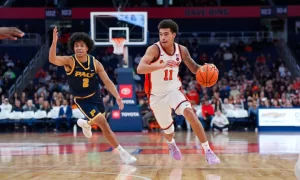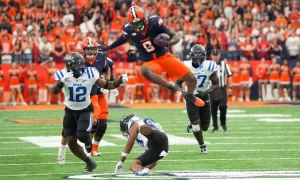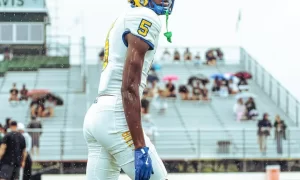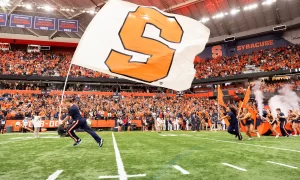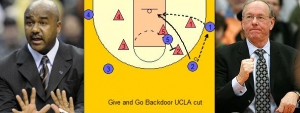 When Syracuse takes on Georgetown tonight, styles will make the fight – the Orange zone vs. the Hoyas’ Princeton offense. You‚Äôve no doubt heard of the Princeton offense, but what exactly is it? As you could probably guess, it was invented and perfected at Princeton by legendary Pete Carril with roots tracing back to the 1930‚Äôs.
When Syracuse takes on Georgetown tonight, styles will make the fight – the Orange zone vs. the Hoyas’ Princeton offense. You‚Äôve no doubt heard of the Princeton offense, but what exactly is it? As you could probably guess, it was invented and perfected at Princeton by legendary Pete Carril with roots tracing back to the 1930‚Äôs.
Over the years, the offense has spread around the country by Princeton system graduates in the coaching ranks, including John Thompson III of Georgetown.
The basis of the Princeton is movement: both player movement and ball movement. In theory this should be the case in any offense, but what makes the Princeton unique is how those players move.
The entire system is based off back-door cuts, meaning a player cuts from the perimeter, behind a defender towards the basket. Against a man-to-man defense wing players “cut to post,” slice toward the hoop, knowing they’re probably not gonna get there because it would require their defender to completely fall asleep. Instead they cut with the intention of establishing deep post position. A guard who knows how to post-up with good position is nearly impossible to defend because most guards don’t know how to play interior defense.
If the post-up isn’t there, the player simply clears out and the process is repeated. Keep in mind that this is just one base option. For instance if the defender plays to prevent the post-up, the cutter can break off his route and step out for what is usually a wide open jumper. Now that you’ve swallowed that, remember there is also another guy who has the ball and three other players moving and picking at the same time.
Ask any coach,¬†like our conversation with Fran Frischilla previewing tonight’s game, and they‚Äôll tell you ball motion and man motion is the key to any offense because it gets the defense moving. A defense in motion is more likely to make a mistake, creating easy offense for the opponent. The Princeton takes this to the next level, because teams often run for a full 35 seconds, knowing that eventually the defense will slip up just long enough to get a quality shot.
But what changes when Syracuse plays its patented 2-3 zone?
If Austin Freeman makes his backdoor cut against Scoop Jardine, Scoop is simply going to let him go and meet a big like Rick Jackson. Unlike a man defense where the defender goes with the offensive player, a zone defender simply passes a cutting player onto the next guy. The Princeton solution: the players no longer “cut to post” but “cut to score” meaning they’re looking for the ball and an easy layup.
But if cutters are simply getting passed around the zone, when are they open to score? This question likely decides tonight’s game and leaves Syracuse with the ultimate fear: it could come down to how well Fab Melo and Baye Moussa Keita play defensively against a system they‚Äôve probably never seen before. (Cue 30,000 people gasping in horror!)
There are two weaknesses in the 2-3 zone – the high post and the short corners (in between the wing and the center on either baseline). Both of these spots cause multiple defenders to react to the ball, leaving a numbers advantage for the offense on the rest of the court while the defense scrambles to recover.
The Princeton tries to take advantage of these two spots as the ball moves with the intention of winding up in either spot. Cutters then move to fill the voids created by the moving defense for the aforementioned quality shots. When done successfully, it is devastating against a zone. This is why¬†Greg Monroe was a force against Syracuse’s defense, he was an outstanding passer from the high post.
Let’s see how Boeheim chooses to defend the high post pass. The first line of defense is the guards getting ball pressure and denying the passing lane. Once the pass is in and¬†the center steps up, it’s imperative the wings communicate and not allow an easy layup as the rim is left unprotected.
Also vitally important – how the center approaches the ball. Keita and Melo are both 7-footers, and they need to use every inch of their wingspan to cut down passing lanes as they closeout. If a cutter is open for a split second, but there is no lane to get him the ball, he might as well not be open. That split second gives the rest of the defense time to recover, and maybe even time for Brandon Triche or Scoop to crash the high post, strip the ball and head the other way with the magic bean.
In reality, playing zone against the Princeton is very similar to playing against any other offense. It’s about communication, crisp rotations, and locating shooters. Unlike a typical offense, Syracuse will have to do these things for nearly 30 seconds on every possession. If the Orange can do this without having mental lapses, they should be able to beat the Hoyas. If not, the biggest snowball effect in Syracuse will having nothing to do with mountains of snow outside, and the momentum of the wins at UConn and South Florida will melt way.
Posted: Craig Hoffman


